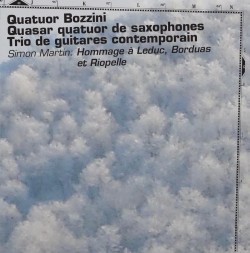 Simon Martin – Hommage à Leduc, Borduas, et Riopelle
Simon Martin – Hommage à Leduc, Borduas, et Riopelle
Quatuor Bozzini; Quasar quatuor de saxophones; Trio de guitares contemporain
Ambiances Magnétiques Collection QB CQB 1616 (quatuorbozzini.ca)
The young composer Simon Martin has created three separate works here with highly distinct instrumentation in homage to a trinity of closely linked Québécois painters central to the history of Canadian art. The first piece L’heure mauve, inspired by the Ozias Leduc painting and the last of these works to be composed (2009), is performed by a trio of classical guitarists. Historically, Martin has arrived at the earliest of these painters last and he’s matched Leduc’s symbolist landscape with an extraordinary minimalism, organizing a piece that matches periods of silence with complex rhythmic patterns created on strummed flurries or plucked notes on open strings.
Projections libérantes (2007), named for a text by Paul-Émile Borduas, was composed for Quasar saxophone quartet. The piece uses saxophone multiphonics created by alternate fingerings and shifting embouchures to mine the instruments’ sonic resources, drawing, for example, simultaneous low-frequency blasts and whistling highs from the baritone.
That sonic creativity is matched by Martin’s handling of the string quartet in Icebergs et Soleil de minuit — Quatuor en blanc, which takes its inspiration from Jean-Paul Riopelle’s series of black and white paintings. It’s a series of brief vignettes, sometimes highly gestural, in which Quatuor Bozzini explores different textures often employing harmonics to create a kind of richly nuanced transparency, a contradictory dense thinness of sound resembling the texture of a painted surface, as clusters can gradually reduce to single attenuated pitches.
What ties these works together is Martin’s fascination with the physical matter engaged by these painters and the power of brush or spatula strokes in their work, qualities transferred to his own dramatic exploration of individual instrumental timbres and subtly evolving sounds. The ultimate effect resembles the dynamic stillness and material transformation that links his three subjects’ work. It’s music of power, beauty and originality, worthy of its subjects.



